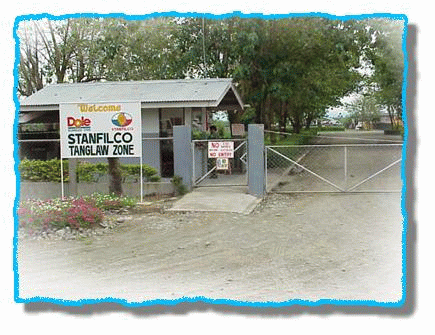

�
�
Please click the following
of interests:
�
Stanfilco History
�
�
�

�
Back
to
About Stanfilco
�
Updated by:
JP Mercado
Sept. 12, 1999
|
.gif)
.gif)
Standard (Philippines) Fruit Corporation or STANFILCO, A Division of Dole Philippines Incorporated, is acclaimed as the forerunner of the banana industry in the Philippines. It is basically engaged in the production of Cavendish bananas mainly for export to various markets in the world. Its primary export channels are Japan, Korea and the Middle East.
The Beginnings
Stanfilco traces its earliest beginnings to the year 1899, then known as Vaccaro Brothers and Company, it added shipping to its banana importing business and consequently changed the business name to Standard Fruit and Steamship Company.
On October 1964, Standard Fruit sold 55% of its interest to Castle and Cooke, Inc.. Four years later, Castle & Cooke, now known as Dole Food Company, bought 100% of Standard Fruit's shares. Consequently, the label of exported fruits was changed from "Cabana" to "Dole" Bananas.
Stanfilco in the Philippines
It was in July 1966 when Standard (Philippines) Fruit Corporation was chartered by the government to engage in the export of bananas. On November 2 of that same year, the vessel MV Benny Skou docked at the Calumpang Wharf in General Santos City, formerly Dadiangas. It carried a cargo of some 176,000 selected Cavendish banana seeds all the way from the Central American plantations of Standard Fruit and Steamship Company. It was a fortuitious moment for Stanfilco and for the Philippines.
The decision to plant bananas for the first time on a commercial scale in the Southern Mindanao area was a product of a painstaking three-year extensive study and research on the targeted area of operation - the fertile, flat lands of General Santos City.
Stanfilco's beginning was also marked by the introduction of a unique farming concept, a system called the Independent Small Growers Program. Under this program, local farmers grow bananas for the company while retaining full control of their lands.
Initially, the program was met with skepticism. Out of hundred of farmers in the area, only a handful initially responded to the program. Over the years, however, the number of farmers who participated in the program has grown tremendously. To date, there are an estimated 3,688 Stanfilco independent growers.
To help nurse Stanfilco's early operations, outside technical expertise was called in, combining efforts with regularly employed technicians. New roads were opened and a whole network of canals was carved through rows and rows of new banana plantings. The existing drainage system was also improved to prevent clogging and overflowing during the rainy season. And to facilitate and expedite the shipping of exportable bananas, plants for washing, weighing and packing were constructed.
From an initial shipment of 4,138 boxes, Stanfilco's exports grew to 29,755 boxes at the end of 1968.
From General Santos in South Cotabato, Stanfilco expanded its operation to North Davao the following year. An initial 81 hectares in Manay and Mabuhay in Panabo were planted. Reaping success in its new venture, 700 hectares more were planted a year lated.
Presently, Stanfilco's farm areas in the Davao province comprised of Kapalong, Sto. Tomas, Panabo, Carmen, Compostela, Osmiguel, Maragusan and Tanglaw, produce the greatest bulk of the company's total volume of production. Recent increasing demands in the foreign market spawned the expansion of the company's operations to Tanglaw, Kinamayan, Compostela, and Maragusan in Davao del Norte.
Following these expansion, Stanfilco small growers in 1996 has a total 7,092 hectares of farm areas cultivated.
And for every Stanfilco associate, this growth represents years of hard work, perseverance, determination and dedicated service to bring the company to its number one status.
(Source: Stanfilco's Benefits Primer).
Back to About Stanfilco
|
.gif)
.gif)


